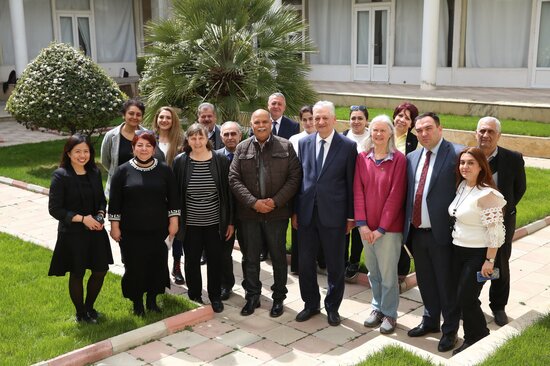Azerbaijan: National Genebank
Location
Baku, Azerbaijan
Parent Organization
Genetic Resources Institute of the Azerbaijan National Academy of Sciences
Mission
- Conservation of agrobiological diversity
- Protection of genetic diversity of domestic animals and plants, including economic and cultural value
- Expanding the use of traditional plant species and animal breeds that are resistant to adverse environmental factors amid global climate change
- Strengthening biodiversity conservation capacities, assessment of existing and required opportunities, preparation of proposals and collaborating with NGOs and international organizations
- Strengthening cooperation with non-governmental and international organizations in enhancing human resource knowledge and skills in the field of biodiversity.
Date Established
2003
Number of Samples Conserved
11,944, including 1,527 in field genebanks (as at June 2023)
Main Crops Conserved
- Grain cereals — wheat, barley, maize, rice
- Grain legumes — pea, lentil, bean, soybean, groundnut
- Vegetables — tomato, cucumber, pepper, eggplant, onion, garlic, cabbage, potato, water-melon, melon, pumpkin
- Forages — lucerne, khasha, maize
- Fruits and berries — grape, apple, pear, apricot, peach, cornel, quince, pomegranate, fig, almond, walnut, hazel, date
- Technical plants — cotton, sugar beet, tobacco, liquorice, tea
- Medicinal and aromatic plants — hips, rose
Background
The current genebank division began its activities in 2004 as a subgroup of the Genetic Resources Institute (GRI). In 2011, the Cabinet of Ministers declared the GRI as the National Coordinating Institute on PGR.
The GRI currently comprises three technical departments – the National Genebank, the Plants Department and the Evaluation Department. The Plants Department and Evaluation Department contribute to the regeneration, characterization and evaluation of the accessions conserved by the Genebank. The Institute also has eight field stations.
- The collection grew from 246 accessions in 2005 to nearly 10,000 by the end of 2022.
- The collection includes 13 genera of cereals, 8 genera of legumes, 9 genera of technical (or commodity crops), 32 genera of vegetables, 19 genera of fodder, 69 genera of medicinal and aromatic plants and 36 genera of fruit/nut crops.
- More than 2,000 accessions are safety-duplicated at the Svalbard Global Seed Vault or at other sites outside Azerbaijan.
- The Genebank distributes an average of about 700 accessions a year, mostly to users within Azerbaijan.
The Collection
Genebank core activities are undertaken by a dedicated genebank team supported by experts and staff from various departments and from other institutions. The practices for various genebank operations are described in the genebank manual developed by the Genebank managers following generally the best practices in the FAO genebank guidelines.
Azerbaijan is a center of origin for a number of globally important food crops, including rye, wheat, barley, millet, pears, cherry and grapes. Forests in the country contain wild ancestors of apples, persimmons, walnuts, chestnuts, pistachios and many other species that have been widely domesticated. Some 800 indigenous species are of medicinal value, of which some 150 are used commercially.
Cereals account for the largest share of the crops conserved in the Genebank, although there are nearly 1,000 accessions of cotton and nearly 700 accessions of grapes.
As part of the Crop Wild Relatives Project, staff from the National Genebank collected wild relatives of alfalfa, apple, barley, carrot, faba bean, grasspea, oat, pea, rye, sorghum, vetch and wheat.
Stories on Azerbaijan
Support for National Genebanks Underway
Seeds maintained in genebanks worldwide are the foundation of our future food and nutrition security.
16 Jun 2022







